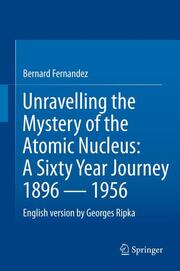Detailansicht
Unravelling the Mystery of the Atomic Nucleus
A Sixty Year Journey 1896 1956
ISBN/EAN: 9781489985620
Umbreit-Nr.: 7383138
Sprache:
Englisch
Umfang: xviii, 530 S.
Format in cm:
Einband:
kartoniertes Buch
Erschienen am 15.10.2014
Auflage: 1/2014
- Zusatztext
- Unravelling the Mystery of the Atomic Nucleus is a history of atomic and nuclear physics. It begins in 1896 with the discovery of radioactivity, which leads to the discovery of the nucleus at the center of the atom. It follows the experimental discoveries and the theoretical developments up to the end of the Fifties.Unlike previous books regarding on history of nuclear physics, this book methodically describes how advances in technology enabled physicists to probe the physical properties of nuclei as well as how the physical laws which govern these microscopic systems were progressively discovered. The reader will gain a clear understanding of how theory is inextricably intertwined with the progress of technology. Unravelling the Mystery of the Atomic Nucleus will be of interest to physicists and to historians of physics, as well as those interested development of science.
- Kurztext
- Unravelling the Mystery of the Atomic Nucleus tells the story of how, in the span of barely sixty years, we made a transition from the belief that matter was composed of indivisible atoms, to the discovery that in the heart of each atom lies a nucleus which is ten thousand times smaller than the atom, which nonetheless carries almost all its mass, and the transformations of which involve energies that could never be reached by chemical reactions. It was not a smooth transition. The nature of nuclei, their properties, the physical laws which govern their behaviour, and the possibility of controlling to some extent their transformations, were discovered in discontinuous steps, following paths which occasionally led to errors which in turn were corrected by further experimental discoveries. The story begins in 1896 when radioactivity was unexpectedly discovered and continues up to the nineteen-sixties. The authors describe the spectacular progress made by physics during that time, which not only revealed a new form of matter, namely nuclei, but also modified our way of thinking by developing quantum mechanics and the theory of relativity.The book is written in a clear and non mathematical language which makes it both accessible and instructive to laymen, physicists and students, as well as to historians of science. It delves into subjects which are of utmost importance for the understanding of matter in our universe and for understanding how this knowledge was achieved.
- Autorenportrait
- Bernard Fernandez, a graduate from the Ecole Polytechnique in Paris, is a physicist from Saclay, France, a laboratory of the French Atomic Energy Commission. He performed experiments on nuclear structure using the Van de Graaff Tandem accelerator and later on the GANIL heavy ion accelerator located in Caen. From 1965 to 1967 he spent two years in the University of Washington in Seattle and in 1976-1977 a year at the Niels Bohr Institute in Copenhagen. In 2008 the French edition of this book was awarded the Médaille Marc-Auguste Pictet by the Physics and Natural History Society of Geneva.Georges Ripka, a physicist from the same laboratory in Saclay, worked on nuclear theory, condensed matter and particle physics. In 1963 he spent a year in the University of Pittsburgh and a further two sabbatical years in the University of Princeton (1967) and the Massachusetts Institute of Technology (1978). Since 1999 he has also worked in the European Center for Theoretical Physics in Trento, Italy. He is the author of several books, including Quantum Theory of Finite Systems (co-author with Jean Paul Blaizot), MIT Press, 1986 and Vivre Savant sous le communisme, Editions Belin, 2002. In 1995 he was awarded the Alexander von Humboldt Stiftung prize.
